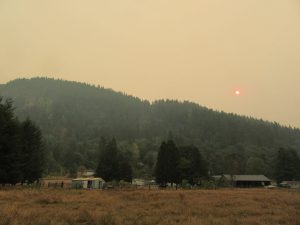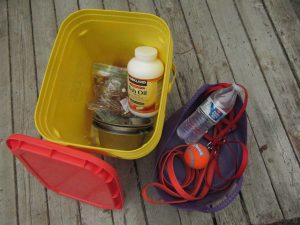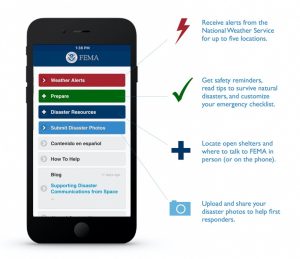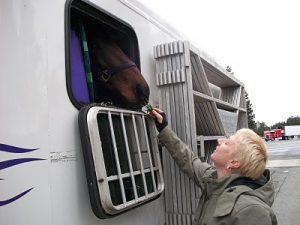In which we alleviate worry by planning and preparing stuff
NOTE: Much of this post was lifted from a similar blog post I wrote for the King County Library blog as a resource for library patrons who need the information. I've changed a few things before posting on this site, mostly because readers here already know who the players are.
The basic information and links remain relevant to Haiku Farm blog readers near and far, especially given the "UPDATE" at the bottom. --Aarene
I admit it: I'm a worrier.

In summer, I worry about forest fires.
In winter, I fret about freezing temperatures, power outages, and treacherous roads.
In spring, I brace myself for flooding.
In fall (for lack of anything better to do) I am uneasy about earthquakes, tsunamis, and the zombie apocalypse.
Because I'm a farmer in addition to my day job, my primary concern in an emergency is the care of, and possible evacuation of animals--both pets and livestock.
We have an evacuation plan at Haiku Farm, and we are prepared to use it. We've prioritized everything on the farm in order of importance, so if we ever hit Level Three: Leave Now, we don't have to stop and think about what gets loaded into the truck first and what gets left behind.
The priority list is as follows:
1. People
2. Animals (pets and livestock)
3. Computers
4. Artwork
Everything else is replaceable. Yes, replacing the books, the clothes, and my mom's piano would suck, but the stuff listed in the priority list is unique, and not replaceable at all.
The priority list is as follows:
1. People
2. Animals (pets and livestock)
3. Computers
4. Artwork
Everything else is replaceable. Yes, replacing the books, the clothes, and my mom's piano would suck, but the stuff listed in the priority list is unique, and not replaceable at all.
But what if you don't have a plan yet?
Here are starting points so you can be ready to evacuate animals safely on short notice:

Ready.gov (part of Homeland Security) recommends an "emergency kit" for each animal, similar to the emergency bag you might assemble for each member of the family.
You may be able to combine emergency kits for animals with similar needs.
Because we have three dogs, two cats, as well as various chickens, goats, and a horse, we make a kit for each species, rather than a bag for each animal.
For example, my dog suitcase contains supplies for all three dogs for up to 2 weeks.
Dog Kit:
- food and meds in individually labeled baggies
- leashes
- bowls
- medical records
- a tennis ball or favorite toy
You may also want to include a sweater for tiny, elderly, or fragile dogs plus one of your own, unwashed t-shirts as a comfort object for frightened dogs. If you have room for a crate for each animal and your dogs are crate trained, bring crates for each dog. A crate can be a secure, worry-free place for dogs to hang out when there is chaos all around.

Cat Kit:
- food and meds
- leash (if your cat will accept a leash)
- bowls
- medical records
- a towel (if your cat will not accept a leash, wrap your cat securely in a blanket or towel to safely transport him/her outside of a crate)
- sandbox (portable units can be purchased, or make one from a cardboard box)
- kitty litter
Cats will need a secure, escape-proof box or crate for travel. Avoid having a cat loose in a vehicle.
Shelf Pets and Exotics:
- food and meds
- food bowls or pans
- secure carrying case (if regular cage is not portable)
- medical records
- extra bedding
- litter box if appropriate (make one from a shoe box)
- spray bottle for cooling in hot weather
- battery operated heating pad for warming in cold weather
Haiku Farm doesn't (currently) have any guinea pigs or iguanas, but we know readers who do.
Chickens and Other Poultry:
- food and meds
- food bowls or pans
- secure carrying case (poultry may be more comfortable traveling with friends, so be ready with a larger box that can accommodate several birds simultaneously)
- extra bedding
I saw a photo of roosters being evacuated from Key West literally wrapped in newspaper and tape like bundles of fish and chips. I'm not sure I'd prefer to transport the Haiku Farm hens this way...but if time was short and boxes weren't available, it's certainly possible that I would do this.
A friend who has worked with wild bird rescue advises that blue "painter" tape can be used to wrap birds and won't cause damage to feathers. Who knew?
Goats, Cows, Horses, and Other Livestock:
- food and meds
- buckets for feed/water
- halters, harnesses, and lead ropes
- blankets or rain sheets if appropriate
- extra bedding
- portable corral or fencing if you have it
Do not wait until you can smell the smoke to teach your horse or other large animals to lead and load promptly!
In an emergency, time is vital, and refusal to load may mean getting left behind.
One of my coworkers laughed when she read the preceding paragraph, because she was sure I was joking. I'm not joking. Load fast, or get left behind (looking at you, goats....)
In an emergency, time is vital, and refusal to load may mean getting left behind.
One of my coworkers laughed when she read the preceding paragraph, because she was sure I was joking. I'm not joking. Load fast, or get left behind (looking at you, goats....)

Level 2: Get set. Make a plan
FEMA's Emergency Planning pages include excellent suggestions for pet owners. These include:
- Pack water first. The quantity will vary depending on the animal(s), but plan to carry at least a 7-day supply for each creature. Remember that flood waters can be contaminated: if you are drinking bottled water during an emergency, your animals will need a safe supply also.
- Keep a photo of yourself with your animal(s) in a place that disaster cannot reach. Post the photo on Facebook or Instagram to store it safely out of the weather. Photos can prove ownership if you get separated from your pet(s).
- Develop a buddy system with neighbors. If you cannot reach your animals at home in an emergency, your neighbors might be able to care for them or assist with evacuation. You may be able to help your neighbors' pets if they cannot get home.
- Post an "Animals Inside" sticker on a house window. Order your FREE pet safety pack, including the Animals Inside from the ASPCA HERE.
- Tell somebody your plan so they know where to look for you. Phone service and internet may be interrupted for several days.
- Make a plan for evacuation options with animals. Pets may not be allowed in public shelters. Consider family or friends outside your immediate area willing to house you and your critters in times of crisis. Other options include pet-friendly hotels, veterinary hospitals, or fairgrounds outside the emergency zone.
- Talk to your vet about emergency planning. Get the name of veterinarians in other cities where you might shelter.
- Consider microchipping your animals and update the microchip information if you move or change your phone number.
- Keep vehicle(s) prepped and ready to go. Make sure fuel and oil is topped up, tires are inflated, and the vehicle is parked conveniently for a quick exit.
Level Three: Leave Now!
Monitor local news and be ready to take action. Do not endanger others with delay.
Download the FEMA app to receive alerts from the National Weather Service, locate open shelters, and upload emergency photos to aid first responders.

When the alarm sounds, move quickly.
- Load supplies first (better yet: keep supplies in the evacuation vehicles)
- Load animal(s) quickly
- Load people
- GO!
Useful Links:
Pets and Animals: Ready.gov general resources for emergency response, including evacuation of pets
Preparing Makes Sense for Pet Owners | FEMA.gov an excellent video showing how and why preparation is important
Preparing Your Pets for Emergencies: Homeland Security printable checklist of necessary items
UPDATE:
Eight days after writing this blog post for the library system, a brush fire broke out 2 miles from here.
25 neighbors went from "just another Thursday afternoon" to Level Three: LEAVE NOW.
 |
| photo stolen from KIRO News 7 |
25 neighbors went from "just another Thursday afternoon" to Level Three: LEAVE NOW.
Haiku Farm is outside the evacuation area, and the fire was contained quickly.
However, the emergency evacuation boxes will remain staged by the front door until we get at least four days of deep, soaking rainfall.
 |
| Stacked by the door. |
I'm also thinking that my next blog post should be titled: What to Do With Your Lottery Winnings: 10 Great Suggestions.





Thank you for posting this!! :D
ReplyDeleteLast week as hurricane Irma was bearing down on: most of the caribbean, the east coast (with a bulls eye on my barely above sea level island), part or all of Florida, or the gulf states, depending on which hour or which model you looked at, I made preparations much as you've described above.
Even though I was somewhat ahead of the game, it was still super stressful. Trying to find accommodations for my horse was especially difficult, as all of the options available could themselves end up in the path of the storm.
The painters tape for birds tip is a good one. I keep a set of giant ziplocs on hand for paperwork, computer, artwork, photos etc. Our disasters tend to be water/wind related.
Having all of this info organized, bullet pointed etc is VERY helpful - thanks again!